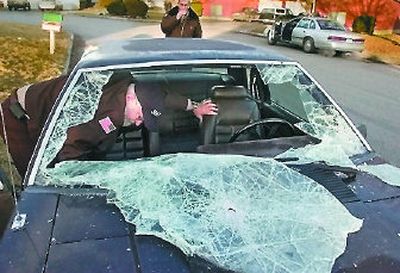TAGGING CREW

Its windshield was shattered into a million pieces that still clung together in that strange way that auto glass does. And there were wet, rotten clothes spotted with mold on the floor in front of the passenger seat.
But what told Ken Tadlock that this car had been left for dead was the way its front end was raised several inches higher into the air than its rear. Prying open the hood of the tired Mustang and peering in the engine bay, he found what he suspected – a fairly unobstructed view of the street below. The radiator and several other organs belonging to this 1983 Ford Mustang were missing.
“Didn’t look like it had a motor in it to me,” said Tadlock, a community policing volunteer who spends every Friday with partner John Baldwin rounding up Spokane Valley’s abandoned vehicles.
There are a lot of abandoned cars on the streets of Spokane Valley. Last year alone, volunteers with the Sheriff’s Community Oriented Police Effort responded to more than 1,400 abandoned vehicle cases in Spokane Valley. Not all of those vehicles were ripe for the wrecking yard. Volunteers investigated another 537 cases in Spokane County.
“We had a Montana RV, 2004 fifth-wheel towed. They’re expensive,” Baldwin said.
The problem wasn’t the RV’s condition, but rather where it was parked. It is illegal under Spokane Valley parking laws to leave a vehicle parked in the public right of way for more than 24 hours. The idea is to keep the right of way clear for plowing and city work, to keep intersections as visible as possible and also to keep Spokane Valley neighborhoods from looking like wrecking yards.
Cars left alone for long periods of time become magnets for theft and vandalism, which doesn’t just stop at the curb. And cars like the ‘83 Mustang parked in a cul-de-sac off of Sullivan Road run a neighborhood down. It’s a relatively small number of cars abandoned that have been picked of all functional parts and left to rust – 180 last year.
Cars deemed worthy of only pennies per pound as scrap metal are given to the towing companies that take turns hauling Spokane Valley’s junk vehicles away.
But towing companies aren’t cooperating with SCOPE for the scrap metal profits alone. They also collect impound fees for functional cars that are towed away and are stored for 30 days in case an owner wants to claim them. Impound fees can dwarf the $101 ticket charged to someone whose abandoned vehicle actually winds up being towed.
After 30 days in the impound lot, the car becomes the property of the towing company.
Abandoned vehicle owners are given roughly a week after receiving towing notices before their options run out. Baldwin and Tadlock mark the cars as problem cars then leave them alone until making the rounds again the following Friday.
However it can be weeks if not months before an abandoned vehicle is first chalked and the process of getting rid of it officially starts. Neighbor complaints or complaints by city officials are what get the ball rolling.
“This car, it’s the first time it’s been tagged, but it’s been out here a long time,” said Baldwin, as he glued a towing notice on the window of a silver Honda Civic parked on South Pines Road. “I know because I live on 22nd and I drive by here every day.”
The purpose of the program, Baldwin said, isn’t to tow someone’s car from the right of way, but rather to get it off the street. The program seems to be working.
Last year, of the 1,472 abandoned vehicle incidents checked out by SCOPE volunteers, only 138 resulted in towed vehicles, according to the SCOPE Abandoned Vehicle Activity Report. Only 547 cars were actually reached the point of being tagged for towing. The rest were moved off the street voluntarily by owners.